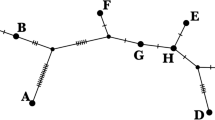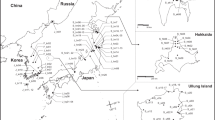Abstract
In the US, clonal growth of Fallopia japonica, Fallopia sachalinensis and their hybrid Fallopia x bohemica (Polygonaceae) is prominent, yet sexual reproduction and hybridization contribute to the genetic complexity of swarms. The contribution to this diversity from multiple introductions is unknown. Using 800 bp of the non-coding chloroplast marker accD–rbcL, we compared 21 Japanese haplotypes with 46 US samples from 11 states, 2 Canadian samples, and 6 European samples from 4 countries, in order to investigate if there were repeated introductions from Asia. While most North American and all European haplotypes accessions in our collection matched a single widespread haplotype, we identified 8 other haplotypes. Three haplotypes of F. japonica (including the widespread haplotype) and one F. sachalinensis matched previously identified Japanese haplotypes, supporting the hypothesis of multiple introductions in the US. Five additional US haplotypes were detected once. Four of these differed from Japanese haplotypes by one single nucleotide polymorphism (SNP), possibly indicating a recent in situ change. The fifth haplotype represents a garden cultivar, which differed from all F. japonica haplotypes. It therefore appears that the US genetic diversity of these taxa has three sources: intra-specific reproduction, inter-specific reproduction, and multiple sources of introduction.

Similar content being viewed by others
References
Bailey JP, Conolly AP (2000) Prize-winners to pariahs-A history of Japanese Knotweel s.l. (Polygonaceae) in the British Isles. Watsonia 23:93–110
Bailey JP, Stace CA (1992) Chromosome number, morphology, pairing, and DNA values of species and hybrids in the genus Fallopia (Polygonaceae). Plant Syst Evol 180:29–52. doi:10.1007/BF00940396
Bailey JP, Child LE, Wade M (1995) Assessment of the genetic variation and spread of British populations of Fallopia japonica and its hybrid Fallopia x bohemica. In: Pyšek P, Prach K, Rejmánek M et al (eds) Plant invasions-general aspects and special problems. SPB Academic Publishing, Amsterdam, pp 141–150
Bailey JP, Bimova K, Mandak B (2008) Asexual spread versus sexual reproduction and evolution in Japanese Knotweed s.l. sets the stage of “Battle of the Clones”. Biol Invasions (http://dx.doi.org/10.1007/s10530-008-9381-4)
Barney JN, Whitlow TH, Lembo AJ Jr (2008) Revealing historic invasion patterns and potential invasion sites for two non-native plant species. PLoS One 3(2):e1635. doi:10.1371/journal.pone.0001635
Bram MR, McNair JN (2004) Seed germinability and its seasonal onset of Japanese knotweed (Polygonum cuspidatum). Weed Sci 52:759–767. doi:10.1614/P2002-053
Chiang TY, Schall BA, Peng CI (1998) Universal primers for amplification and sequencing a noncoding spacer between the atpB and rbcL genes of chloroplast DNA. Bot Bull Acad Sin 39:245–250
Clement M, Posada D, Crandall K (2000) TCS: a computer program to estimate gene genealogies. Mol Ecol 9:1657–1660. doi:10.1046/j.1365-294x.2000.01020.x
Dlugosch KM, Parker IM (2008) Founding events in species invasions: genetic variation, adaptive evolution, and the role of multiple introductions. Mol Ecol 17:431–449. doi:10.1111/j.1365-294X.2007.03538.x
Ellstrand NC, Schierenbeck KA (2000) Hybridization as a stimulus for the evolution of invasiveness in plants? Proc Natl Acad Sci USA 97:7043–7050. doi:10.1073/pnas.97.13.7043
Facon B, Pointier JP, Jarne P et al (2008) High genetic variance in life-history strategies within invasive populations by way of multiple introductions. Evol Ecol 18:363–367
Forman J, Kesseli RV (2003) Sexual reproduction in the invasive species Fallopia japonica (Polygonaceae). Am J Bot 90:586–592. doi:10.3732/ajb.90.4.586
Gammon MA, Grimsby JL, Tsirelson D et al (2007) Molecular and morphological evidence reveals introgression in swarms of the invasive taxa Fallopia japonica, F. sachalinensis, and F. x bohemica (Polygonaceae) in the United States. Am J Bot 94:948–956. doi:10.3732/ajb.94.6.948
Grimsby JL, Tsirelson D, Gammon MA et al (2007) Genetic diversity and clonal vs. sexual reproduction in Fallopia spp. (Polygonaceae). Am J Bot 94:957–964. doi:10.3732/ajb.94.6.957
Hollingsworth ML, Bailey JP (2000) Evidence for massive clonal growth in the invasive weed Fallopia japonica (Japanese Knotweed). Bot J Linn Soc 133:463–472
Inamura A, Ohashi Y, Sato E et al (2000) Intraspecific sequence variation of chloroplast DNA reflecting variety and geographical distribution of Polygonum cuspidatum (Polygonaceae) in Japan. J Plant Res 113:419–426. doi:10.1007/PL00013950
Lavergne S, Molofsky J (2007) Increased genetic variation and evolutionary potential drive the success of an invasive grass. Proc Natl Acad Sci USA 104:3883–3888. doi:10.1073/pnas.0607324104
Lee CE (2002) Evolutionary genetics of invasive species. Trends Ecol Evol 17:386–391. doi:10.1016/S0169-5347(02)02554-5
Leger EA, Rice KJ (2003) Invasive California poppies (Eschscholzia californica Cham.) grow larger than native individuals under reduced competition. Ecol Lett 6:257–264. doi:10.1046/j.1461-0248.2003.00423.x
Leger EA, Rice KJ (2007) Assessing the speed and predictability of local adaptation in invasive California poppies (Eschscholzia californica). J Evol Biol 20:1090–1103. doi:10.1111/j.1420-9101.2006.01292.x
Mandák B, Pyšek P, Lysák M et al (2003) Variation in DNA-ploidy levels of Reynoutria taxa in the Czech Republic. Ann Bot (Lond) 92:265–272. doi:10.1093/aob/mcg141
Mandák B, Pyšek P, Bímová K (2004) History of the invasion and distribution of Reynoutria taxa in the Czech Republic: a hybrid spreading faster than its parents. Preslia 76:15–64
Mandák B, Bímová K, Pyšek P et al (2005) Isoenzyme diversity in Reynoutria (Polygonaceae) taxa: escape from sterility by hybridization. Plant Syst Evol 253:219–230. doi:10.1007/s00606-005-0316-6
Pyšek P, Brock JH, Bímová K et al (2003) Vegetative regeneration in invasive Reynoutria (Polygonaceae) taxa: the determinant of invasibility at the genotype level. Am J Bot 90:1487–1495. doi:10.3732/ajb.90.10.1487
Richards CL, Walls RL, Bailey JP et al (2008) Plasticity in salt tolerance traits allows for invasion of novel habitat by Japanese knotweed s.l. (Fallopia japonica and F. x bohemica, Polygonaceae). Am J Bot 95:931–942. doi:10.3732/ajb.2007364
Rozen S, Skaletsky HJ (2000) Primer3 on the WWW for general users and for biologist programmers. In: Misener S, Krawetz SA (eds) Bioinformatics methods and protocols: methods in molecular biology. Humana Press, Totowa, pp 365–386
Shaw RH, Bryner S, Tanner R (2009) The life history and host range of the Japanese knotweed psyllid, Aphalara itadori Shinji: potentially the first classical biological weed control agent for the European Union. Biol Control. doi:10.1016/j.biocontrol.2009.01.016
Taberlet P, Gielly L, Pautou G et al (1991) Universal primers for amplification of three non-coding regions of chloroplast DNA. Plant Mol Biol 17:1105–1109. doi:10.1007/BF00037152
Thompson JD, Gibson TJ, Plewniak F et al (1997) The ClustalX windows interface: flexible strategies for multiple sequence alignment aided by quality analysis tools. Nucleic Acids Res 24:4876–4882. doi:10.1093/nar/25.24.4876
Tiébré M, Vanderhoeven S, Saad L et al (2007) Hybridization and sexual reproduction in the invasive alien Fallopia (Polygonaceae) complex in Belgium. Ann Bot (Lond) 99:193–203. doi:10.1093/aob/mcl242
Ward SM, Gaskin JF, Wilson LM (2008) Ecological genetics of plant invasions: what do we know? Invasive Plant Sci Manage 1:98–109. doi:10.1614/IPSM-07-022.1
Whitney KD, Gabler CA (2008) Rapid evolution in introduced species, ‘invasive traits’ and recipient communities: challenges for predicting invasive potential. Divers Distrib 14:569–580. doi:10.1111/j.1472-4642.2008.00473.x
Yonekura K, Ohashi H (1997) New combinations of East Asian species of Polygonum s.l. J Jpn Bot 72:154–161
Zhou Z, Miwa M, Kara K et al (2003) Patch establishment and development of a clonal plant, Polygonum cuspidatum, on Mount Fuji. Mol Ecol 12:1361–1373. doi:10.1046/j.1365-294X.2003.01816.x
Acknowledgments
We thank John Bailey, Pluma Beyer, Denise Deering, Jennifer Forman Orth, Cindy Kalkwarf, Christoph Methfessel, Christopher A. Militscher, Nick Page, Luca Paltrinieri, Julie Richburg, Dina Tsirelson, and Peter Zika for contributing tissue samples; Dina Tsirelson for contributions in the lab; three anonymous reviewers, and Jim Allen for assistance in the University of Massachusetts Boston greenhouse.
Author information
Authors and Affiliations
Corresponding author
Rights and permissions
About this article
Cite this article
Gammon, M.A., Kesseli, R. Haplotypes of Fallopia introduced into the US. Biol Invasions 12, 421–427 (2010). https://doi.org/10.1007/s10530-009-9459-7
Received:
Accepted:
Published:
Issue Date:
DOI: https://doi.org/10.1007/s10530-009-9459-7




